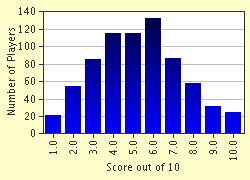Quiz Answer Key and Fun Facts
1. When the serpent tempted Eve he was very careful to keep his words truthful - it was a masterful piece of manipulation designed to fool her into believing him and tasting the fruit. A similar story is found in 'The Magician's Nephew' where Digory is in conversation with Jadis over the Apple in his pocket. What did Jadis say which stopped him from taking the Apple home to his mother?
2. In the chapter 'How Bree became a Wiser Horse' the proud war stallion Bree met Aslan for the first time. Bree had sung the praises of the land of Narnia throughout 'The Horse and His Boy', telling Shasta about the Talking Beasts who lived in freedom. He did not believe, however, that Aslan was really a Lion, and an important lesson was learned when he came face to face with the Lion himself and was challenged to touch his body. Which Biblical character had an experience which mirrors this part of Bree's history?
3. Lucy was called by Aslan in the middle of the night in 'Prince Caspian' - something similar to the incident when the young Samuel is called to speak to God in the dark hours. Which of the following statements is true?
4. Given that Paul the Apostle persecuted Christians (Acts 9:1) before his miraculous encounter on the Damascus Road (Acts 9:3) and subsequent conversion (Acts 9:17-18) when the scales fell from his eyes and he was baptized (Acts 9:18), and that he went on to evangelise the known world (Acts 14;1-7 among others), which of the children would you say most closely resembles this biblical character?
5. Which biblical King put things in Jerusalem back to rights in a similar way to what King Caspian did in the land of Narnia?
6. After the Resurrection Jesus appeared to the Disciples and his followers many times; on one of these occasions they were out fishing and saw Jesus on the shore. Peter jumped out of the boat and swam ashore to him to see that Jesus had lit a fire and was cooking breakfast (John 21:1-14). Which of the children had a similar experience (but for the swim!)?
7. When Peter, Susan and Lucy are walking to meet with Aslan they meet Father Christmas, who gives them special Gifts which become part of Narnian history. Peter's sword defeats the Wolf and Aslan knights him with it, Susan's Horn is the means of bringing the children back to Narnia to help Prince Caspian and Lucy's cordial is used when she is sailing on the Dawn Treader as well as after various battles. Spiritual Gifts are mentioned in the New Testament, including 1 Corinthians 12. Verse 11 shows that the Gifts of the Spirit are similar to the Gifts given in 'The Lion, the Witch and the Wardrobe', but in what way?
8. Only twice did any characters pray to Aslan throughout the Chronicles. One took place in the final book, 'The Last Battle', when King Tirian was tied to a post and appealed to Aslan to save him and the rest of Narnia, and if he could not come in person, to allow his voice to travel across the worlds to speak to the Friends of Narnia himself. Did Aslan grant his request?
9. Both the Narnia Chronicles and the Bible have a good share of memorable characters; which of the following pairs could be considered to be alike, given that both are pessimistic and inclined to gloominess?
10. When people think of biblical connections with the Narnia Chronicles, one incident is likely to spring to mind before any other - Aslan's sacrifice in 'The Lion, the Witch and the Wardrobe'. There are many parallels but also a lot of poetic licence if one wanted to compare the two objectively. Which of the following statements is true of the Biblical account of Jesus' death and resurrection, but not true of the story of Aslan's death and resurrection?
Source: Author
ArleneRimmer
This quiz was reviewed by FunTrivia editor
trammgr before going online.
Any errors found in FunTrivia content are routinely corrected through our feedback system.

